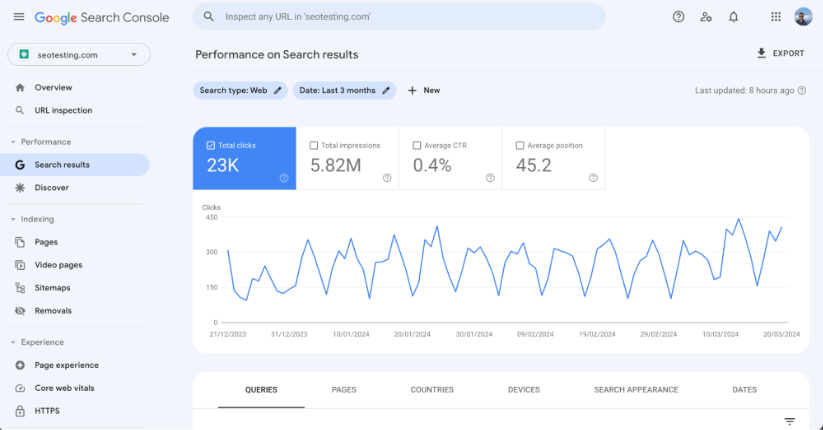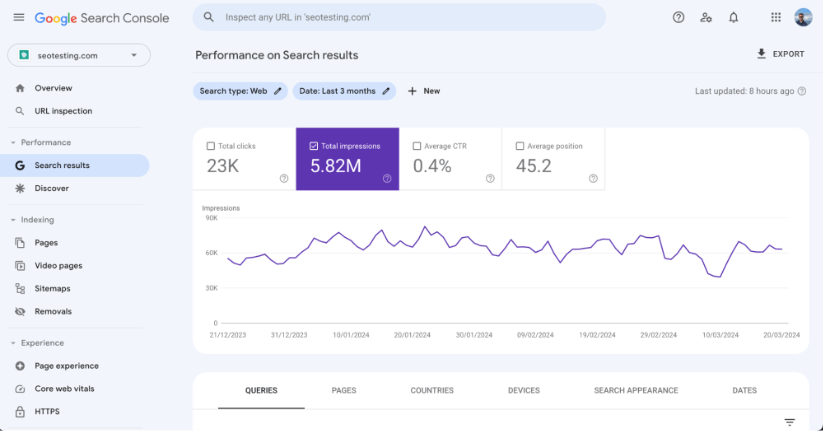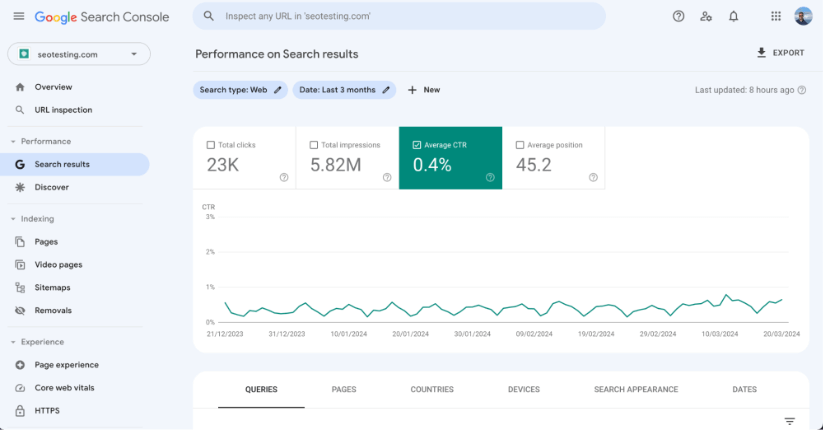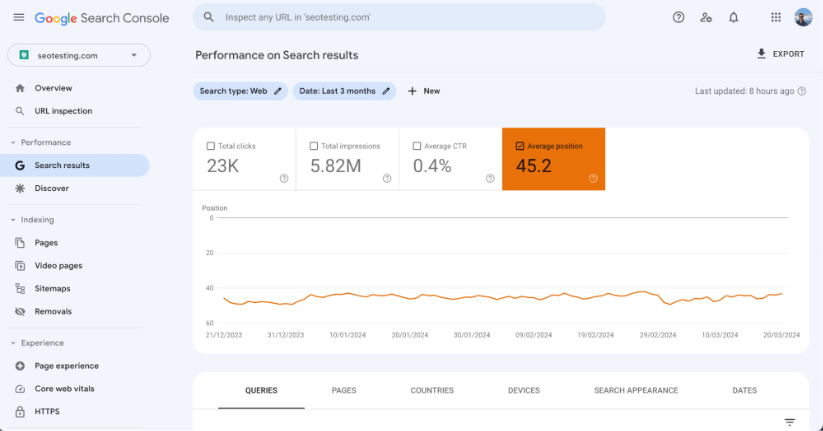Google Search Console is one of the most widely used SEO tools. It’s a free tool offered by Google that allows webmasters, SEO professionals, and other marketers to monitor their organic website traffic and see how Google crawls and interacts with your website.
But just how accurate is it? Is it a reliable tool? This article will discuss Google Search Console’s accuracy, what data it holds about your site, and the differences between first-party and third-party data.
How Accurate is Google Search Console?
Generally, Google Search Console is very accurate in providing insights into a website’s performance within Google Search. It sources its data directly from Google’s search results, which will naturally offer website owners a reliable overview of:
- Their site’s search traffic.
- Ranking data.
- Crawl errors and issues.
- Issues with website visibility in search.
Data reporting can have minor discrepancies or delays, especially with real-time data, given that GSC needs 48 hours to display your website data. However, overall, instances of data reporting inaccuracy are rare.
What Data Does Google Search Console Provide About My Website?
Google Search Console offers a wealth of information about your website, but its strengths lie in giving you data on your clicks, impressions, click-through rate, and your website’s average position across Google Search.
In this section, we’ll give you a quick explanation of what these metrics are and why they are helpful to SEO professionals.
Click Data
Click data within Google Search Console refers to the number of times users on Google have clicked through to a website from their search results. This data is crucial for understanding how effectively a website attracts visitors from organic search.

For SEO professionals, click data is invaluable for optimizing a website’s search engine performance. It will help you find which keywords and pages drive traffic to your website, enabling you to create targeted content and adjust your keyword strategy. By understanding which search queries lead to clicks and which do not, you can refine your content to match user intent better, improve your website’s CTR, and boost your website’s visibility.
Impression Data
Impressions within GSC show the number of times a website’s pages appear within Google’s search results, regardless of whether they are clicked on. This metric gives you a broader picture of your website’s visibility on Google, indicating how often people find your website listing in their search queries.

Analyzing impression data is essential for identifying opportunities to improve performance. High impressions but low clicks indicate a page is visible but needs to be more appealing and relevant to attract a click. This insight allows you to optimize meta titles and descriptions to increase CTR.
Click-Through Rate Data
Your click-through rate is a fundamental metric that measures the ratio of clicks to impressions for a website’s listings in the SERPs. It is calculated by dividing the total number of clicks by the total number of impressions and multiplying that result by 100 to express it as a percentage.

Your website’s click-through rate directly indicates the effectiveness of its SEO strategies and the appeal of its content. Analyzing your CTR will help you identify which pages or keywords are performing well and which may require work to improve their appeal in search results. For example, a low CTR may indicate that you need to revise your meta descriptions to make them more engaging to the user.
Average Position Data
When looking at your Google Search Console dashboard, your average position is the metric that calculates the mean ranking of a website’s pages in the SERPs for specific queries. This figure provides a snapshot of where your web page typically appears in search engine results for users’ searches.

Why average position? This is because your exact ranking is incredibly variable! Your position in the SERPs will be impacted by things like geographical location, a user’s past search history, the actual query that has been typed, your site’s speed at the current time, and even the user’s internet speed.
Understanding and monitoring your average position over time is crucial for devising and refining SEO strategies. This metric will help you identify the strengths and weaknesses of your website’s search performance across your targeted keywords and phrases.
How Accurate is the Click Data Within Google Search Console?
The click data shown within Google Search Console is highly accurate for understanding the performance of individual pages. GSC provides direct insights from user interactions when assessing the number of clicks a website or a specific page receives from Google’s search results. This means that for an overarching view of a site’s traffic or the performance of particular pages, the click data is reliable and does reflect the actual engagement levels from Google.
However.
When breaking down click data by query, the accuracy becomes more nuanced due to Google’s approach to privacy. Google samples query data to protect users, meaning that not every query and the associated clicks are recorded individually.
Generally, the accuracy of click data for specific queries improves with the volume of clicks a query receives. Popular queries with high click numbers tend to have more precise data, as the sampling has less impact on the overall accuracy. It’s important that SEOs and webmasters have this in mind, as it’s easier to trust the data for high-traffic queries while less popular queries require being mindful of potential sampling biases.
How Accurate is the Impression Data Within Google Search Console?
The impression data within Google Search Console is generally very accurate. This data is pulled directly from Google search, ensuring that it reliably captures the exposure of website content in search. Impressions are counted each time a page appears in a search result, providing a comprehensive view of a site’s overall visibility in Google search.
However, it is essential to note that Google Search Console aims to provide as accurate and detailed data as possible within the bounds of privacy and practicality. While impression data is usually precise, Google tends to apply filters that ensure user privacy and data integrity. For example, Google might aggregate data in certain places to prevent the identification of individual user behaviors.
Nonetheless, these things do not significantly reduce the overall accuracy and use of impression data for SEO purposes. It’s still incredibly accurate overall.
How Accurate is the Click-Through Rate Data Within Google Search Console?
While insightful, the click-through rate metric within Google Search Console is subject to the various limitations of sampled data, which affects its precision.
While click and impression data are generally accurate, query data (which contributes to these metrics) can often be sampled, so the CTR for specific queries may not always reflect exact user behavior.
Sampling means that not every interaction is recorded; instead, a subset is used to estimate total behavior. This approach can introduce variability, especially for less popular queries with fewer searches, making the CTR less reliable. This effect is mitigated for high-volume queries due to the more significant data set, which leads to more accurate CTR calculations.
As a general rule of thumb, the more searches the query gets, the higher the accuracy of the CTR you get.
How Accurate Is the Average Position Data Within Google Search Console?
The accuracy of your average position generally increases with the number of impressions a query gets. For high-traffic queries, where many impressions are recorded, the data tends to be much more accurate and reflect a website’s actual search engine standing. This is because the larger volume of data helps mitigate fluctuations and anomalies, providing a more precise and stable view of your website’s average position.
However, for queries that receive fewer impressions, the accuracy of the average position data can be much less reliable. This decrease in reliability is partly due to personalization factors in search results, where Google will tailor search outcomes to individual users based on factors such as:
- Their search history.
- Their location.
- Their device type.
Such personalization means different users may see your website at various positions for the same query, leading to a broader spread in the reported average position. As a result, the average position metric might reflect far less accurate results for queries with lower impression counts than queries with larger impression numbers!
First-Party Data vs Third-Party Data
This next section will discuss first-party and third-party data and give examples of each. We will also answer whether GSC data is classified as first-party or third-party.
What is First-Party Data?
First-party data is data companies collect directly from their sources about their users or customers. This data includes details gathered from interactions on websites, mobile apps, social media, surveys, customer feedback, and transactions. It is highly valued for its accuracy, relevance, and trustworthiness, as it comes from the company’s audience and is collected with consent.
What is Third-Party Data?
Third-party data is information organizations acquire from external sources not directly connected to the user or customer interaction with the company’s platforms. These sources can include data providers, ad networks, and analytics services, offering insights into broader trends, behaviors, and preferences beyond the company’s immediate reach.
Is Google Search Console Data First-Party?
The data within Google Search Console is first-party data.
This data comes directly from Google’s servers, reflecting the interactions between their users and your website as it appears in Google’s search results. It is collected and provided by Google specifically for website owners, making it a direct source of information on how the site performs in the SERPs, which is essential for SEO and overall website improvement.
What are Examples of Third-Party Data?
There are lots of examples of third-party data, especially within SEO. Any data that does not come directly from a search engine (Google Search Console, Google Analytics, and Bing Webmaster Tools) can be classified as third-party. This includes data from tools such as Ahrefs, Semrush, BuzzSumo, Hotjar, and CrazyEgg.
My Google Search Console & GA4 Data Don’t Match Up
When you notice differences between your Google Search Console and Google Analytics data, various factors are at play. Understanding these factors will help you get over these data differences and make more informed decisions based on the insights they provide.
Google Analytics Doesn’t Show Data if JavaScript is Blocked
Google Analytics relies heavily on JavaScript to track user interactions on your website. If a specific visitor has JavaScript blocked within their browser’s settings, GA will not record the data from that visit. This is a very common scenario as many online users prioritize high levels of privacy and use older browsers that do not have JavaScript enabled by default.
Privacy Extensions Impact Google Analytics’ Ability to Collect Data
Privacy-based extensions (especially ad blockers) can affect Google Analytics’ ability to collect data. These tools often prevent GA tracking codes from being executed properly, which leads to underreported data in Google Analytics compared to Google Search Console. GSC collects data directly from search results and is completely independent of browser settings.
Google Discover Traffic is Aggregated in Google Analytics & Independent in GSC
Another important distinction is how Google Discover traffic is handled by both Google Analytics and Google Search Console.
Google Analytics aggregates data from Google Discover and shows it with other acquisition channels, this means it will be shown in your organic traffic acquisition channel within Google Analytics. On the other hand, Google Search Console shows Google Discover data separately.
Google Analytics Data is Real-Time. Google Search Console Data is Delayed
There are also differences in the timeframe for data reporting between Google Analytics and Google Search Console. Google Analytics reports data in near real-time, with updates every few minutes. Google Search Console is typically updated once per day and 2 days behind.
Sampled Data Plays a Role Here
Why do clicks within Google Search Console and the total number of clicks for the page only sometimes add up?
This all comes from data sampling. Google Search Console, as already discussed, uses sampling in its reports to estimate search data. This means that the sum of individual query clicks may sometimes differ from the total clicks reported for a page because the data is an aggregation of sampled data points, not a comprehensive record of every interaction.
Wrapping Things Up
Google Search Console emerges as an exceptionally reliable and precise tool for SEO professionals and webmasters aiming to enhance their website’s performance on Google Search. It directly taps into Google’s vast repository of search data, delivering invaluable insights into website traffic, ranking data, crawl errors, and visibility issues.
Despite minor discrepancies or delays, especially in real-time data reporting, the accuracy of the data provided—be it clicks, impressions, click-through rates, or average positions—is generally high, making it an indispensable asset.
This analysis also unpacks the nuances of first-party versus third-party data, positioning Google Search Console’s data as first-party owing to its direct collection from Google’s servers. This distinction underscores the data’s relevance and trustworthiness for website owners.
Moreover, discrepancies may arise between Google Search Console and Google Analytics data due to JavaScript blocking, privacy extensions, and data sampling. However, understanding these differences can lead to more informed decisions and strategic adjustments.
Ultimately, Google Search Console stands out for its accuracy and depth of insight into a website’s search performance. Whether you’re refining SEO strategies, enhancing content to match user intent, or addressing technical issues, Google Search Console provides a comprehensive, accurate, and utterly indispensable toolkit for succeeding in the digital realm.
Are you looking for a way to supercharge your Google Search Console data? Give SEOTesting a try! We have a wide range of reports to use your GSC data better, allowing you to use it to optimize your website and increase revenue. We have a 14-day free trial with no credit card required, so give us a try now.

